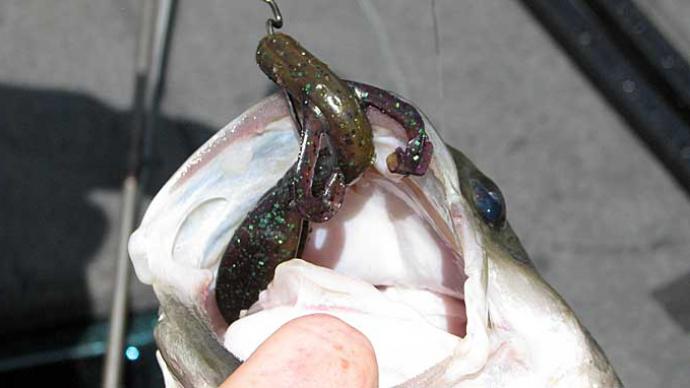
If you’ve put away your buzzbaits because the water is getting “too cool,” you’ve made a mistake. I’ve caught more bass on buzzbaits in 50-degree water than at 70-degree temperatures, yet most anglers think hot water makes for optimum buzzbait fishing.
Don’t get me wrong; you can catch bass on these noisy lures when the water is warm. But cooler temperatures can trigger quality buzzbait action. And it all starts right now when the bass start moving shallow, and it runs into early winter.
It’s one of my favorite techniques for fishing lakes with various aquatic vegetation. However, shallow logs and stumps in the backs of creeks are premium targets for fall buzzbait action, too.
Cooler water will create a plankton bloom that, in turn, makes the shad run on the surface. When that happens, game fish suspend and look for anything scooting over the top.
I’ll never completely understand why a buzzbait seems to have such a broad appeal to a big fish. It’s long been my experience that the buzzbait will attract bigger fish and more vicious strikes than any other topwater baits I’ve ever used. You can fish buzzbaits right out of the package, but I like to customize them to offer a different appeal in appearance and sound.
That’s not to say a stock buzzbait doesn’t work, but there are tricks you can employ to make a buzzbait better.
Sound is a good example. The faster you fish a buzzbait, the more noise it tends to make. However, sometimes you may discover a deeper sound created by a slower retrieve will be even better. Generally, the slower you can run a bait and keep it on the surface is the most productive.
The bass will tell you which they prefer. I recommend you experiment to find the one that attracts more aggressive strikes.
For example, I’ve filed down the head to make a bigger bait lighter. I’ve wrapped lead solder around the bait if I need to add weight so I can fish it faster and make it run a little deeper in the water, which creates a different noise. Or, I may put a big, soft plastic trailer on the back to slow it down and make it less noisy. The type of soft plastic trailer helps you control that. Some of the trailers I’ve used over the years include Berkley Chigger Craws, straight worms, split-tail trailers, and curly-tail trailers.
Another thing that has paid big dividends for me the past few years is to remove the skirt that comes on a buzzbait and glue a 4-inch Berkley Hollow Belly swimbait on the hook shaft. I’ll also paint the head to match the swimbait. That can be highly productive in clear water.
I prefer light-colored or even translucent buzzbaits, opting for darker colors only on rainy, low-light days or for night fishing. I don’t fish after dark very often, but when I do, I’ll have a black buzzbait tied to a rod.
I will fish sizes ¼ to 1 ounce. Again, it depends upon the speed, sound, and appearance I think the fish prefer.
Buzzbaits do attract short strikers, which is why I will add a trailer hook unless I’m fishing the bait through really heavy cover. If I still need the trailer, I’ll thread the trailer hook eye into a piece of surgical tubing and stick the eye over the buzzbait hook point, and that helps keep the hook straight and in place so it doesn’t roll over and snag. If the cover isn’t an issue, I’ll let the hook hang free.
Regardless of which bait you prefer, remember that the buzzbait can be a good lure into early winter. I’ve caught some great stringers on a buzzbait in South Carolina the week before Christmas when the water was 52 degrees.
So, when cooler temperatures roll onto your lake this fall, don’t forget the buzzbait. It might catch you the bass that you’re missing with other techniques.
You can find more articles, quick tips, and more at HankParker.com.




